News
New Reports Examine What Makes an Enterprise AI Leader
Just like with individual workers, enterprises are finding varying degrees of success in dealing with transformative GenAI technologies, and several studies have sought to explore what makes the difference.
Judging from the volume of such studies, it appears to be an important question that's tough to answer, with two new reports from Rackspace Technology and IBM both taking different approaches to examine the gap between AI-first enterprises that are thriving and those that are lagging behind.
Rackspace's "2025 Global AI Report: The AI Acceleration Gap: Why Some Enterprises Are Surging Ahead" analyzes responses from more than 1,400 global IT decision-makers to reveal why a small group of "AI Leaders" are achieving significant ROI and competitive gains, while the majority of firms remain stuck in early-stage adoption.
IBM's "From AI Projects to Profits: How Agentic AI Can Sustain Financial Returns" draws on two recent executive surveys to examine how "AI-first" enterprises are translating AI maturity into sustained operating profit improvements and strategic market advantages.
Together, these reports paint a detailed picture of what separates today's AI-first leaders from their peers. While their approaches and terminology differ, both studies converge on several core themes that help explain why some enterprises are profiting from advanced AI adoption -- and why others are falling behind.
Of special interest to readers of Virtualization & Cloud Review are discussions of cloud computing. For example, the Rackspace report highlights how cloud strategy underpins AI leadership, noting that "more than half of AI Leaders (52%) use a hybrid cloud strategy, compared to just 35% of other organizations." This blended approach "lets them run AI workloads where it makes the most sense, combining the flexibility of public cloud with the control and compliance benefits of private infrastructure." Meanwhile, the IBM report emphasizes the importance of integrated data platforms and orchestration across "hybrid estates," suggesting that successful AI-first organizations increasingly rely on cohesive platforms that span both cloud and on-premises environments to support scalable AI operations.
The two different approaches of the studies are reflected in how they summarize their findings on the AI leadership issue.
Rackspace's report emphasizes the accelerating divide between a small cohort of AI Leaders and the rest of the market. As the report puts it, "The faster businesses enter an accelerating AI loop of efficiency and capability, the faster they can advance." The study warns that "those who stay stuck in the early stages of development for too long face a trap: not being able to develop AI because they can't prove ROI, and then falling further behind while competitors accelerate."
IBM's study highlights how AI maturity is reshaping competitive dynamics. The report concludes, "The organizations demonstrating superior capabilities and strategy are not simply experimenting more successfully -- they are fundamentally reshaping the terms of competition in their industries." It notes that AI-first organizations are distinguished not only by current performance, but by their ability to "create entirely new opportunities that did not previously exist."
Both reports also devote considerable attention to the emerging role of agentic AI -- autonomous AI systems and agents that can independently perform tasks, learn, and collaborate with human teams. Rackspace's report notes that "four in five AI Leaders want to implement AI that's capable of working autonomously," highlighting a growing appetite for embedding agentic AI deeper into business processes. Already, 77% of AI Leaders surveyed have AI agents in production and are actively expanding their use.
IBM's study puts even more emphasis on the transformative potential of agentic AI. It concludes that "agentic AI systems -- those that can make decisions and take action with limited human oversight -- are rapidly becoming an essential component of enterprise strategy." Notably, IBM found that AI-first organizations are more likely to leverage agentic AI to create entirely new products, services, and business models, not just incremental improvements.
Both studies suggest that agentic AI will increasingly define the next wave of enterprise differentiation. As IBM's report states: "Organizations that can operationalize agentic AI at scale will gain the agility and innovation capacity required to reshape competitive landscapes." The result is a race not just to adopt AI, but to embed increasingly autonomous AI capabilities at the heart of how enterprises operate.
The extensive reports each cover a lot of territory, so here are some salient takeaways or data points on the AI leadership gap taken from each:
Rackspace Technology: The AI Acceleration Gap: Why Some Enterprises Are Surging Ahead
- Small group of AI Leaders is pulling ahead: 13% of firms are classified as AI Leaders, having comprehensively implemented AI throughout their organizations and aligned it with business strategy.
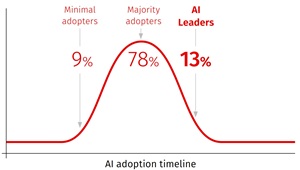 [Click on image for larger view.] AI Adoption Timeline (source: Rackspace).
[Click on image for larger view.] AI Adoption Timeline (source: Rackspace).
- Significant ROI advantage: 64% of AI Leaders report significant ROI from AI -- twice the rate of their peers.
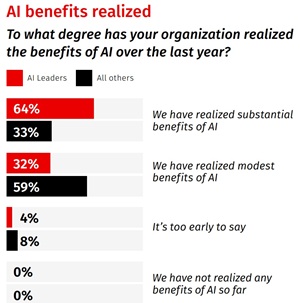 [Click on image for larger view.] AI Benefits Realized (source: Rackspace).
[Click on image for larger view.] AI Benefits Realized (source: Rackspace).
- AI agents in production: 77% of AI Leaders have AI agents in production and are actively expanding their deployment.
- AI as competitive advantage: 87% of AI Leaders view AI as a core competitive advantage, not just an automation tool.
- Workforce readiness: 76% of AI Leaders say their employees have the training and skills to work effectively with AI, compared to 42% of other organizations.
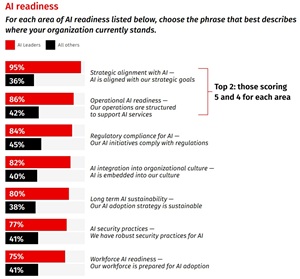 [Click on image for larger view.] AI Readiness (source: Rackspace).
[Click on image for larger view.] AI Readiness (source: Rackspace).
- Risk of falling behind: "Those who stay stuck in the early stages of development for too long face a trap: not being able to develop AI because they can't prove ROI, and then falling further behind while competitors accelerate."
IBM: From AI Projects to Profits
- AI-first organizations lead in performance: 25% of organizations qualify as "AI-first" adopters, and show outsized revenue and operating profit improvements attributable to their AI initiatives.
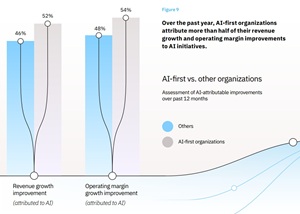 [Click on image for larger view.] AI Firstness (source: IBM).
[Click on image for larger view.] AI Firstness (source: IBM).
- Shift toward core business transformation: AI investments are increasingly being redirected toward core business functions, rising from 64% in 2025 to an expected 70% in 2027. This shift reflects a growing recognition that AI delivers the greatest value when embedded in key competitive capabilities.
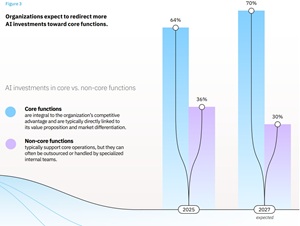 [Click on image for larger view.] AI Redirect (source: IBM).
[Click on image for larger view.] AI Redirect (source: IBM).
- Reshaping competition: "The organizations demonstrating superior capabilities and strategy are not simply experimenting more successfully -- they are fundamentally reshaping the terms of competition in their industries."
- Innovation and new opportunities: AI-first organizations are more likely to "create entirely new opportunities that did not previously exist."
- Portfolio approach to innovation: 68% of AI-first organizations treat AI initiatives as an innovation portfolio, balancing near-term projects with transformative bets (vs. 54% of others).
- Data and governance maturity: 68% of AI-first organizations have mature and robust data and governance practices, compared to 32% of others.
- Strategic advantage through data: "The leaders have recognized that no algorithmic sophistication can compensate for poor data hygiene -- and have invested accordingly."
- Creating new customer and market opportunities: AI-first organizations are more likely to leverage AI to reach new customers and markets, not just to optimize existing processes.
Both reports make it clear that achieving AI leadership is not about deploying the most advanced models or biggest budgets alone. Instead, it depends on a deliberate organizational strategy -- one that integrates AI into core business functions, treats data as a strategic asset, empowers the workforce, and creates a culture ready to adapt and innovate. For enterprises seeking to move beyond AI experimentation and into profitable transformation, the lessons from these studies are well worth heeding.
About the Author
David Ramel is an editor and writer at Converge 360.